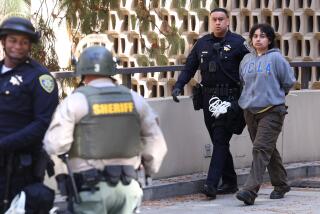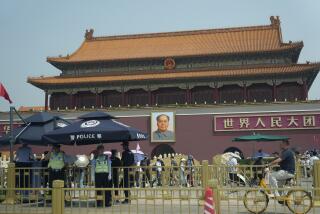For some Hong Kong protesters, Tiananmen still casts a shadow
Reporting from Hong Kong — Every night around 1 a.m. for the last five weeks, Jonathan Chan has taken up watch near the Hong Kong government office complex. As pro-democracy demonstrators settle in for the night, he watches like a hawk for any movement of police on the perimeter. When rumors have circulated that officers were about to clear the site, Chan has sought to calm anxious protesters.
The fear is not unfounded, a fact Chan knows more intimately than most: Twenty-five years ago, he was demonstrating in Tiananmen Square in Beijing, and when authorities began to clear the area with rifles and tanks, all he could do was gaze helplessly and hopelessly at the maimed and slain student protesters.
“Back then, none of us expected the government to open fire on us students. Even now, the situation seems hopeless,” said Chan, with a look of sadness in his tired eyes. “But between hope and perseverance, I choose perseverance.”
Chan is among several former student activists from Hong Kong who experienced firsthand the crushing end to the 1989 protests and are now giving their support to the democracy demonstrators here. Though they are allowing a new generation of students to take the organizational lead, they are determined to assist however they can.
“Each of us can play a small part,” said Kenneth Lam, another former student leader who, like Chan, managed to flee Tiananmen Square amid gunfire. Now a lawyer in Hong Kong, he has represented Hong Kong students arrested in an earlier civil disobedience protest.
Last month, when democracy protesters were physically attacked by opponents in the Mong Kok neighborhood just two blocks from his law office, Lam rushed out to help them. His glasses were smashed.
Though the 25-year-old trauma of Tiananmen is hardly forgotten, Chan, Lam and others said they feel more optimistic this time. Not because China’s Communist Party leaders are any more willing to embrace democracy, but because there is a broad base of support in Hong Kong for the protesters’ aspirations.
“We were more naive then, and we hoped to get the sympathy from a faction of the Communist Party,” Lam said. “But now in Hong Kong, the civic society is getting stronger than ever, and the people are ready to take to the streets anytime.”
Still, the chances of confrontation increased markedly this week when Hong Kong’s high court ruled that police could start removing barricades and protesters from Mong Kok and an area around a skyscraper near government headquarters.
The ruling enhanced interim restraining orders issued on behalf of the owner of the Admiralty district area skyscraper, who, along with other plaintiffs, said the blockades had hurt business. Police will be authorized to arrest and remove demonstrators who interfere with the plaintiffs’ clearing of the sites.
Protesters in Hong Kong, a former British colony that returned to Chinese rule in 1997 under a framework known as “one country, two systems,” began demonstrating in late September to demand open nominations of candidates for the chief executive election in 2017.
China’s central government in Beijing has instead insisted that all candidates be approved by a special committee, expected to be composed largely of business leaders and other pro-establishment figures.
The protests, led mostly by university students, have seen tens of thousands of people occupy Hong Kong thoroughfares. Although the number of people in the streets has diminished significantly, sit-ins continue in three key districts: Admiralty, Mong Kok and Causeway Bay.
No one expected the movement to last this long — not least because for many a Hong Konger older than 35, the Tiananmen crackdown casts a long shadow.
For six weeks in the spring of 1989, students and workers from across China massed in the square in Beijing, calling for more accountable and democratic leadership. The movement galvanized tens of thousands of Hong Kongers, who not only took to the streets but also ferried money and supplies to Beijing to aid the protesters. Knowing full well their city was to revert to Chinese sovereignty in just eight years, they were very much vested in the fight for democracy playing out on the mainland.
After hope of a democratic China was steamrolled on June 4, 1989, Hong Kongers — even the triad gang members — helped leaders of the Tiananmen protests flee the mainland.
China’s communist leaders have since sought to stamp out any memory of the events. Censors diligently block references to the crackdown from the Internet in mainland China, commemorative events are banned, and the state-run media take no note of the anniversary. Many mainland Chinese born in the last 30 years know little to nothing about what happened.
Hong Kongers, in contrast, have worked hard to keep recollections of Tiananmen alive. Every year, mournful rituals of song and prayer in Hong Kong’s Victoria Park have commemorated the failed democracy movement. This year, an estimated 180,000 people attended the vigil. This spring, a small, privately run June 4 Museum opened in the city.
Fear of another crackdown has therefore loomed large over the Hong Kong protests. In early October, as the movement entered its second week and ominous rhetoric from Beijing escalated, a number of prominent Hong Kong figures, including college presidents, medical school deans and one of the city’s staunchest democracy advocates, Cardinal Joseph Zen, visited the sit-in zones to plead with the students to retreat, warning of grave danger. No one directly mentioned Tiananmen, but it was clearly on their minds. Many students refused the entreaties.
“We’re hamstrung by the belief that history will repeat itself,” said Wong Kwok Kui, a Hong Kong Baptist University humanities professor who spoke last month at a campus workshop on the different generational viewpoints on Tiananmen. “It’s encouraging to see that, unlike us, the students aren’t as straitjacketed by history as we are. And the good thing is they don’t listen to us.”
After spending weeks among the protesters, Chan says, he has more faith in this new crop of student leaders.
“Back then, the students were torn between two diametrically opposite options. Some wanted to retreat while it was still possible. Others succumbed to the martyrdom mentality, and vowed to spill their blood and lay down their lives,” he recalled. “Whereas this generation of students is wiser and more level-headed. And I’m more confident in the students on the tactical level.”
Others, however, are not as sanguine about the chances of the conflict ending peacefully.
Johnny Lau, a Hong Kong political commentator who in 1989 was in Tiananmen Square as a reporter for the newspaper Wei Wei Po, takes a dim view of the powers that be.
“The authorities are stubborn and can act irrationally,” he said. “Even though the circumstances and political considerations confronting the communist Chinese leadership are very different now than before, the danger of violence is still there.”
For the generation of Hong Kongers who have vowed to “never dare forget Tiananmen,” they now find themselves caught between dwelling on failed struggles and soldiering on to fight for a different outcome.
The challenge, said Wong, is to “imbibe history’s lessons without being smothered by them.”
Law is a special correspondent.
More to Read
Sign up for Essential California
The most important California stories and recommendations in your inbox every morning.
You may occasionally receive promotional content from the Los Angeles Times.










